Contents:
Common Names | Parts Usually Used | Plant(s) & Culture | Where Found | Medicinal Properties | Biochemical Information
Legends, Myths and Stories | Uses | Formulas or Dosages | Nutrient Content | How Sold | Warning | Resource Links | Bibliography
Scientific Names
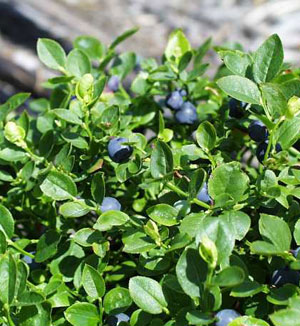
Bilberry |
- Vaccinium myrtillus L.
- Ericaceae
- Heath family
Common Names
- Black whortleberry
- Blueberry (V. angustifolium)
- Burren myrtle
- Dyeberry
- Huckleberry
- Hurtleberry
- Whinberry
- Whortleberry
- Whorts
- Wineberry
Parts Usually Used
Leaves and berries
Back to Top
Description of Plant(s) and Culture
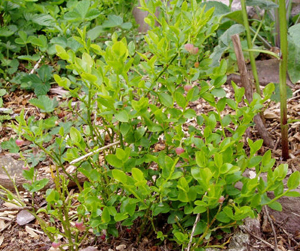
Bilberry |
Bilberry is a shrubby perennial plant; the angular, green, branched stem grows from a creeping rootstock to a height of
According to Culpeper there are two sorts common in England, the black and the red berries. Both used similarly.
Back to Top
Where Found
Grows in the sandy areas, in acid soil, in forests, heaths, rocky barrens, bog and tundra. Northern United States. In the woods and forest meadows of Europe.
Back to Top
Medicinal Properties
Antiseptic, astringent, nutritive, diuretic
Back to Top
Biochemical Information
Fatty acids, hyroquinone, iron, loeanolic acid, neomyrtillin, sodium, tannins, and ursolic acids, quinnic acid (in the leaves) potassium, and
Back to Top
Legends, Myths and Stories
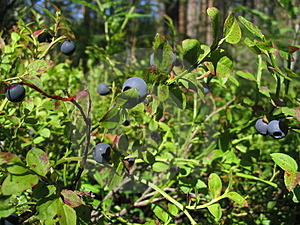
Bilberry growing wild |
Bilberry is a well-known folk remedy for poor vision, especially for people who suffer from “night blindness,” that is, they have difficulty seeing in the dark. In fact, bilberry jam was given to Royal Air Force pilots who flew nighttime missions during World
Used to make wine.
Elizabethan apothecaries made a syrup of the berries with honey, called rob, as a remedy for diarrhea.
Bilberry is a home and industrial leather dye of brown and yellow colors. Combined with other chemicals to produce violet, red, green and blue for wool, cotton and linen material.
Back to Top
Uses
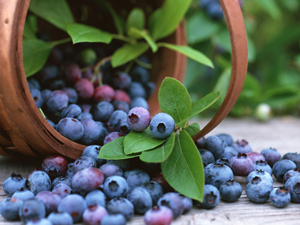
Bilberry fruit |
For diabetes, (bilberry berries increases insulin production, caution should be taken by diabetics and cases of hypoglycemia), sinusitis, kidney and bladder problems, ulcers. Leaves help to lower blood sugar levels and to ease inflammation. The leaf is effective as a remedy for diarrhea. Fresh berries can produce diarrhea in some people and stop it in others. Also the fruit is used for anemia, consumptive wasting, indigestion, and colitis. Roots are used for dropsy, and urinary stones. Dried berries pass through the stomach without affecting it; beginning work in the small intestine. A strong decoction of the berries is said to be used for typhoid fever. Fresh or well-preserved berry juice makes a good gargle for sore throats or as a mouthwash for inflamed gums or for leucoplasia (an inflammation of the tongue producing white patches). Eating the fresh berries help regulate bowel action, stimulate appetite, end intestinal putrefaction which causes gas. Leaf tea used for coughs, vomiting, stomach cramps, and catarrhal enteritis. Externally, use as a wash for skin problems, sores, wounds, ulcers, and burns. Strengthens capillaries that feed eye muscles and nerves reducing and even reversing the damage caused by blood vessel deterioration. Increases night vision, reduces eye fatigue, helpful for nearsightedness (myopia). Helps preserve eyesight and prevent eye damage. At one time, it was used in the treatment of scurvy in Norway and other northern countries.
Back to Top
Formulas or Dosages
Gather the leaves when the plant is fully developed but before the berries are ripe.
Infusion: use
Decoction: use
Extract: mix
Tincture: take
Back to Top
Nutrient Content
Potassium, and
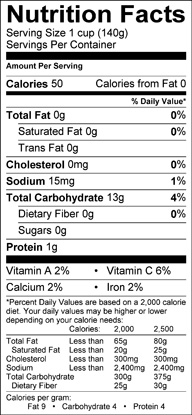
How Sold
Capsules: 1 capsule, from
Back to Top
Warning
Interferes with iron absorption when taken internally.
The leaves lower blood sugar levels, so insulin-dependent diabetics should not take them in infusions without professional supervision.
Leaves can produce symptoms of poisoning if used over long periods.
Back to Top
Resource Links
LiveStrong.com: Bilberry Vs. Huckleberry
LiveStrong.com: Borage Oil & Bilberry
Memorial Sloan-Kettering Cancer Center: Bilberry
National Center for Complementary Medicine: Bilberry
U.S. National Library of Medicine: Bilberry
University of Maryland Medical Center: Bilberry
Glaucoma.org: Alternative Medicine
Bibliography
![]() The Herb Book
The Herb Book, by John Lust, Bantam Books, 666 Fifth Avenue, New York, NY. copyright 1974.
![]() The Nature Doctor: A Manual of Traditional and Complementary Medicine
The Nature Doctor: A Manual of Traditional and Complementary Medicine, by Dr. H.C.A. Vogel; Keats Publishing, Inc., 27 Pine Street (Box 876) New Canaan, CT. 06840-0876. Copyright Verlag A. Vogel, Teufen (AR) Switzerland 1952, 1991
![]() Eastern/Central Medicinal Plants
Eastern/Central Medicinal Plants, by Steven Foster and James A. Duke., Houghton Mifflin Company, 215 Park Avenue South, New York, NY 10000
![]() Planetary Herbology
Planetary Herbology, by Michael Tierra, C.A., N.D., O.M.D., Lotus Press, PO Box 325, Twin Lakes. WI 53181., Copyright 1988, published 1992
![]() The Complete Medicinal Herbal
The Complete Medicinal Herbal, by Penelope Ody, Dorling Kindersley, Inc, 232 Madison Avenue, New York, NY 10016, First American Edition, copyright 1993
 Earl Mindell’s Herb Bible
Earl Mindell’s Herb Bible, by Earl Mindell, R.Ph., Ph.D., Simon & Schuster/Fireside, Rockefeller Center 1230 Avenue of the Americas, New York, New York 10020
![]() Culpeper’s Complete Herbal & English Physician: Updated With 117 Modern Herbs
Culpeper’s Complete Herbal & English Physician: Updated With 117 Modern Herbs, by Nicholas Culpeper, Meyerbooks, publisher, PO Box 427, Glenwood, Illinois 60425, 1990, (reprint of 1814)
![]() Indian Herbalogy of North America
Indian Herbalogy of North America, by Alma R. Hutchens, Shambala Publications, Inc., Horticultural Hall, 300 Massachusetts Avenue, Boston, Massachusetts 02115, 1973
![]() Prescription for Nutritional Healing, Fifth Edition: A Practical A-to-Z Reference to Drug-Free Remedies Using Vitamins, Minerals, Herbs & Food Supplements
Prescription for Nutritional Healing, Fifth Edition: A Practical A-to-Z Reference to Drug-Free Remedies Using Vitamins, Minerals, Herbs & Food Supplements, by James F. Balch, M.D. and Phyllis A. Balch, C.N.C., Avery Publishing Group, Inc., Garden City Park, NY
 The Rodale Herb Book: How to Use, Grow, and Buy Nature’s Miracle Plants (An Organic gardening and farming book)
The Rodale Herb Book: How to Use, Grow, and Buy Nature’s Miracle Plants (An Organic gardening and farming book), edited by William H. Hylton, Rodale Press, Inc. Emmaus, PA, 18049., 1974
![]() Webster’s New World Dictionary
Webster’s New World Dictionary, Third College Edition, Victoria Neufeldt, Editor in Chief, New World Dictionaries: A Division of Simon & Schuster, Inc., 15 Columbus Circle, New York, NY 10023
 A Useful Guide to Herbal Health Care
A Useful Guide to Herbal Health Care, HCBL (Health Center for Better Living).,1414 Rosemary Lane, Naples, FL 34103., Special Sale Catalog, 1996
